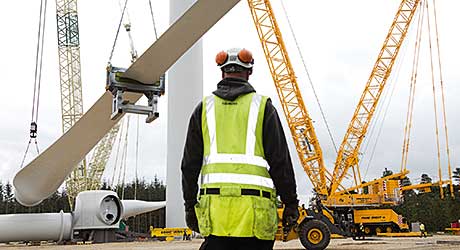
Renewables spending in last 12 months bolstered jobs and order books
RENEWABLE energy has become a crucial lifeline for civil engineering contractors coping with the downturn in traditional projects.
The sector now accounts for £1 in every £8 spent on infrastructure and is estimated to support between 2,000 and 3,000 full-time employees north of the border. It now ranks alongside water and transport as a major source of workload.
The Civil Engineering Contractors Association (Scotland) said the last year saw more than £300m worth of activity in renewables, representing around 15% of the estimated £2 billion of infrastructure investment during the period. And its members are confident the sector will continue to thrive in 2013.
CECA Scotland chairman Roger Philpott, of Perth contractor I&H Brown, emphasised the value of a buoyant renewables sector. “This is all the more important during a recession where renewables is one of the few growth areas in a Scottish construction market that has suffered a dramatic downturn and significant business failures.
“The Scottish Government’s determination to increase renewable power generation and upgrade the distribution network has undoubtedly protected businesses and over 2,000 skilled jobs and, frankly, without renewables many firms, particularly SMEs in Scotland’s more remote and economically sensitive communities, are reporting that they would struggle to keep going.
“CECA Scotland is working closely with the Scottish Government to protect this valuable skill base and calls upon all those involved in funding and assessing new renewables projects to consider the wider economic benefits and jobs that they are providing.”
The optimistic outlook for renewables coincides with chancellor George Osborne’s promise to allocate £330m of new spending to capital projects in Scotland over the next two years. Finance Secretary John Swinney is now drawing up a list of which so-called ‘shovel ready’ projects will benefit from the new investment. A raft of schemes under consideration include eight transport projects valued at £74m, education contracts worth £65m, and 11 health developments worth a total investment of £308m.
Swinney, who has continually called on the UK Government to provide extra cash for infrastructure schemes in Scotland, acknowledged Osborne’s autumn statement was “halfway to commonsense” although he said the Treasury still lacked a coherent plan to return the economy to growth.
The chancellor was forced to admit to the House of Commons the measures he has taken have not produced the hoped-for results but he refused to change tack and warned the country to prepare itself for further austerity.
Further opportunities for Scottish firms to tap into renewables are likely to come via the new Edinburgh-based Green Investment Bank (GIB), which is now open for business. The Scottish Government and GIB have formed an advisory group to help businesses prepare bids for a share of the £3 billion pot set up to finance suitable schemes.
Energy minister Fergus Ewing said CECA’s report highlighted renewables’ importance. “Our renewable sector, including onshore wind, has a key role to play in sustaining the civil engineering sector, and that role will continue to grow as we move towards our 2020 target.”










